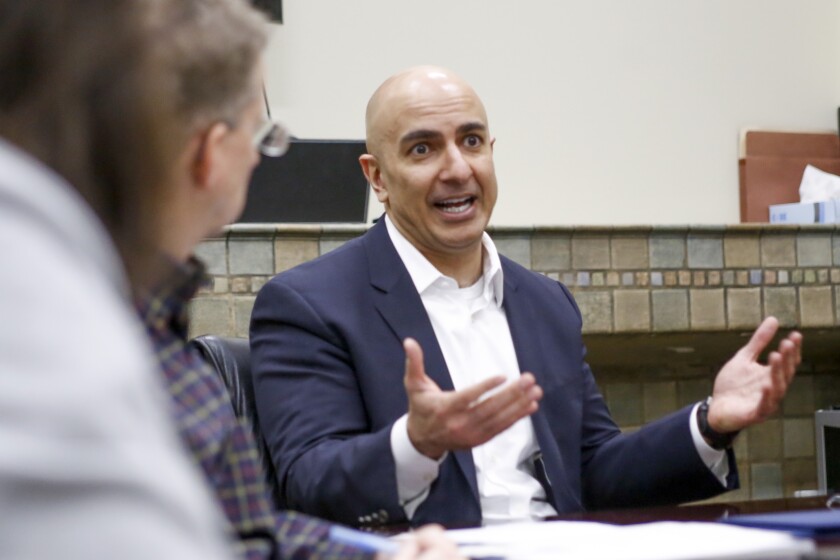FARGO — Neel Kashkari, president of the Federal Reserve Bank of Minneapolis, said it’s premature to cut interest rates based on one disappointing job growth figure — but if two or three sputtering job reports pile up, it might be appropriate to reconsider.
Kashkari has consistently been a dissenting voice on the interest rate-setting Federal Reserve, the nation’s central bank, and did not support many of the multiple incremental rate hikes over the past couple of years.
ADVERTISEMENT
But Kashkari said in a Wednesday, April 3, meeting in Fargo that he does not believe current conditions call for lowering interest rates. He noted that the country has consistently been adding about 200,000 jobs monthly, and monthly economic indicators can be volatile.
“We know that a lot of this economic data is noisy,” he said.
But, he added, “If we have two or three low numbers in a row I’m going to look at the data” and decide whether it would be appropriate to drop rates to stimulate the economy.
There are signs the economy is slowing, he said. “The risk has shifted somewhat to the downside.”
In February, the economy added 20,000 jobs, far below expectations. The government’s March jobs report is due Friday, but a report released Wednesday by ADP and Moody’s Analytics found private payrolls added 129,000 jobs, far short of the 173,000 that economists expected in a survey.
After that report, the Federal Reserve signaled a pause in further interest rate hikes for the year, a move Kashkari supports.
Kashkari is in Fargo visiting with business groups, including a town hall meeting. To keep on top of economic conditions, he regularly travels the Ninth Federal Reserve District, which includes Minnesota, North Dakota, South Dakota, Montana, an area of northwestern Wisconsin and the Upper Peninsula of Michigan.
ADVERTISEMENT
The Fed has a delicate balancing act as it works to advance its dual mission of maintaining stable prices and maximizing employment. It cannot wait too long to raise rates in a growing economy, since failure to act could enable unhealthy inflation, but it also must not raise rates too quickly or too much and risk killing economic growth, he said.
In fact, Kashkari said one of his biggest worries is that the Federal Reserve could raise rates too aggressively and end the prolonged economic expansion that has followed the Great Recession in 2008.
The Federal Reserve’s monetary policy is aimed at maintaining an inflation target of 2 percent. In recent years, inflation has consistently been running below the 2-percent mark, but reached 2.4 percent in 2018 and 2.1 percent in 2017.
A low inflation rate is desirable, Kashkari said, but the Fed tries to steer a course that avoids both high inflation or its reverse, deflation, in which prices fall.
Kashkari said his resistance to interest rate hikes stems from his observation that the economy has kept adding lots of jobs in spite of a consistently low unemployment rate — a sign that many people who had been on the sidelines are entering the job market because they find more attractive job opportunities.
That tells him that there has been “slack” in the labor market, partly because of underemployment.
“A lot of people got thrown out of the labor force” during the Great Recession, and the economy continues to rebound from that, he said.
ADVERTISEMENT
“The healing process from the Great Recession has taken a long time,” Kashkari said. Wages now are growing, however, which is a healthy sign, he added.
Employers frequently complain about difficulty hiring in such a tight job market, but Kashkari said he asks them why they don’t raise wages to attract workers.
Their response is higher wages will lead to higher prices, but experience since the Great Recession has not borne that out. Despite chronically low unemployment, inflation has not spiked in the way conventional economic theory would predict, he said.
Kashkari and his fellow Federal Reserve bankers are keeping an eye on the relationship between short-term and long-term interest rates.
Ordinarily, investors want higher rates for lending money over longer periods. When the interest rates “invert,” short-term rates rates climb higher than long-term lending rates. That recently happened, by some measures.
Interest rate “inversions” are regarded as an accurate predictor of recession, but many economists say it is premature to predict a recession is imminent.
“We don’t know for sure” if the interest rate inversion signals a recession, Kashkari said, though added that it is a clear sign that investors expect slow economic growth over the next few years. He said it's an indicator "flashing yellow, maybe red."
ADVERTISEMENT
He added, “It’s not good."








